Bill,
To my less than certain knowledge, the only wad ever made available
to reloaders which attempted to cover the long shot charge in the three
inch .410 was made by Remington but was discontinued a long time ago,
probably before 1980. It looked like the shorter SP-410, but had thinner
material in the shot protector section. Even so, it was not quite long
enough to cover the whole shot column and left at least 1/8 inch of
the shot column unprotected. If memory serves, the wad was called an
SP-413.
I well recall the introduction of shot shells with shot protectors first,
just shot protectors, and later the one-piece plastic wads with shot
protectors. I was just getting into shotshell reloading in 1964 and
avidly read all the advertising and naively took it at face value, but
I now believe much of it was overstated and/or misunderstood.
The general statement was that patterns were improved by 5%-7%. The
shot protectors unquestionably improved patterns, but advertising claims
probably exceeded any demonstrable advantage. While no doubt some guns
and some loads showed a 5% to 7% denser pattern, such improvement did
not show up across the board. I well recall that one major US company,
Federal, determined that shot protectors gave no pattern improvement
in Skeet loads, and Federal continued to make its Skeet loads without
shot protectors for a number of years after they introduced them in
their trap and hunting loads.
|
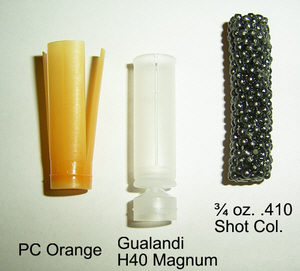
Typical modern .410 wads with containers shorter
than ĺ oz .410 shot column.
|
To
return to the three inch .410, the introduction of the SP-413 wad was
accompanied by the reduction of the shot charge from 3/4 oz. to 11/16
oz. The old paper shells had roll crimps which left a trifle more room
in the case than the folded crimp and used wad columns which could be
as short as 3/16 inch.
The first Remington plastic three inch shell appeared about 1969-70.
It used conventional wads and carried the nominal 3/4 oz. shot charge.
Remingtonís paper ..410s had rolled crimps, but the new plastic case
had a folded (pie) crimp. This load was available only for about a year
before being replaced with shells loaded with plastic wads. When the
replacement with plastic wad came out, the shot charge was reduced to
11/16 oz., most likely to accommodate the plastic wads. I have a couple
of boxes of these shells and you can clearly see the longer wad. However,
it does not cover the entire shot charge, at least 1/8 inch and possibly
3/16 inch is exposed.
For many years I also kept a reference box of the plastic shells with
3/4 oz. shot charge shells. Regrettably, a young friend, unaware of
the reason I kept this box, shot them. He was quite proud when he told
me he chose this box because it had the lowest price marked on it, as
well it should, it was fifteen years old at the time! He had shot the
cheapest ones so as not to use my good shells and paid me full price,
$2.39, as reimbursement. He meant well, and I never told him what he
had done, but I really wish it hadnít happened.
It is always possible, but highly unlikely, that one might find some
of the old Remington wads at gun shows or even old stock in stores.
The wad was not popular probably because the shorter 2 1/2 inch .410
is the standard shell for Skeet and few non-Skeet shooters reload the
.410.
Because of the limited space in .410 bore shells, it is difficult to
get 3/4 of an ounce of shot in them, and, as noted above, even though
it had thinner protective petals, the SP-413 did not cover all of the
shot.
Lyman's Shot Shell Reloading Manual lists a number of 3/4 oz. loads
using the shorter wad in both Remington and Federal shells, but most
current US reloading data for three inch shells calls for the common
2 1/2 inch wads, and no more than 11/16 oz. Of shot. I note that some
data now call for a reduced shot charge of 2/3 oz.
My experience with three inch shells is that the Remington 3 inch case
had the most interior space, but Remington has recently introduced a
shortened 3 inch case which has less internal volume and will hold less.
Winchester compression formed cases don't have room for the 3/4 oz.
shot charge.
|
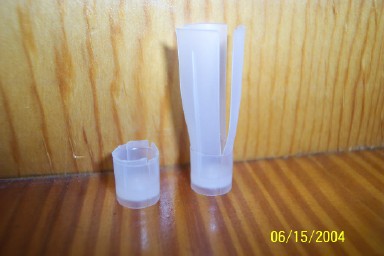
with and without petals
|
How
much does exposing the shot hurt your patterns? I previously opined
not much, but that was before I performed a simple experiment. Since
I live in the country, it is easy to shoot a shotgun in the back yard.
I loaded up two shells with identical components, except I removed the
protective petals from the wad in one shell. The load was 3/4 oz. of
8 1/2s in a three inch Estate shell (probably a Federal case), 15.5
grains of W-W 296, a W-W 209 proimer, and a Claybuster 410 equivalent
wad. As noted, I removed the petals from one wad.
I could not crimp these cases the same way as the load with petals intact
filled one case much fuller than the shell with petals removed. Since
I was not going to carry the shells very far, I took two small pieces
of paper towel each about an inch square, folded it twice to make a
square that was four layer thick and rounghly Ĺ inch on a side. I pushed
this into the case mouths using the eraser end of a pencil. Thus, except
for the missing petals, the two shells were as alike as I knew how to
make them. Any problem with my "crimping system" should have been the
same for both shells.
|
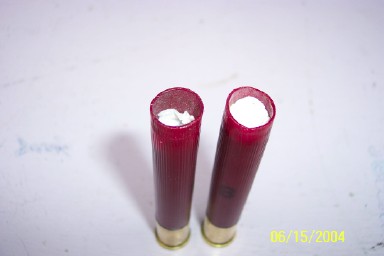
Case closure
|
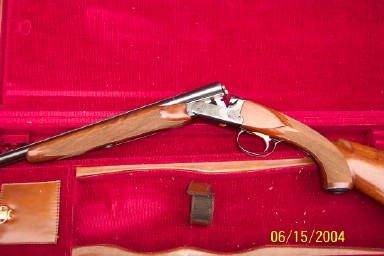
Winchester Pigeon Grade Model
23
|
I thought that if the missing petals were to make a significant difference, they
would do it in the tightest choke. I have a nice old Winchester Pigeon
Grade Model 23 on which the left barrel is so tightly choked that I
cannot get the .410 probe of my Baker Barrel Reader inside to measure
it. The bore measures ..407 inches, about standard, and I estimate the
choke to be under .375 inch, extremely tight for a .410. A .410 normally
requires only about .020 inches of constriction for full choke effect
and this one is .032 inches, enough for a full choke in some 12 gauge
guns.
Using this barrel, I shot a pattern at a measured 20 yards with each
shell. The reason I choose 20 yards is that usually it is close enough
to catch all the shot in a pattern. Moreover, it is exactly half the
standard distance of 40 yards and by drawing a 15 inch circle, half
of the diameter of the standard 30 inch circle, around the densest part
of the pattern, I can accurately estimate pattern percentages.
|
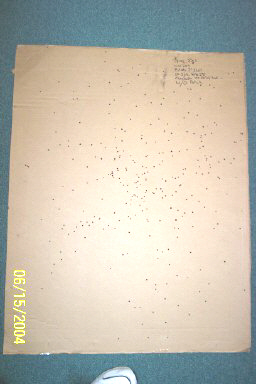
Without petals
|
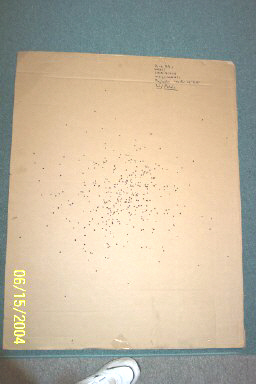
With Petals
|
I have not yet counted the exact number of pellets in each pattern,
but the photos show that the pattern from the shell with the unaltered
wad was extremely tight, probably exceeding 75%, while the pattern without
the protective petals was much more open, probably approaching only
about 50%.
The results were astonishing to my not easily astonished eyes and my
opinion that the petals make little difference is clearly wrong in a
tight choked .410. The wad with protective petals patterned way denser
than the wad without the patterns.
As for the best powder for the .410, I find that 296 is as good as any,
and, if you are going for maximum loads, it takes up significantly less
space than most.
Incidentally, I gather that you are attempting to use your three inch
..410 for 16 yard singles. (To the British and Australian shooters,
this is essentially what is called "down the line, single shot" except
Americans shoot five targets from each position before moving on to
the next and they donít use the annoying horn to note misses.) I have
shot only one game with a .410 and that was in about 1968 before plastics
replaced paper shells. I broke a 17/25 using a rather unlikely gun,
a Remington 11-48 with full choked plain barrel. My breaks were satisfactory,
but the whippy little barrel played hob with my pointing.
Although I have been shooting Skeet and other games for 40 years, I
took up trap shooting regularly just two years ago. I have often used
very light loads. I frequently shoot 16 yards with a 20 gauge Remington
870 Lightweight with 28" modified barrel and my daughters often use
the gun. We use two loads, the standard Remington 7/8 oz. dove and quail
load with cheap shot and the WalMart variation with just 3/4 oz. of
cheap #8s, but at the rather high velocity of 1275 fps. My best score
with either load has been 49/50, and I have done it on a couple of occasions
with both loads. I also have shot 24/25 with a 28 gauge 870 with a modified
choke and standard Skeet load, 3/4 oz. of 9s, so I am convinced that
a 3/4 oz. load will work very well at 16 yards, and a three inch ..410
also should do nearly as well.
I would make one subtle change if I were reloading 3/4 oz. .410s, for
doves or for trap; I would use # 8 Ĺ shot. I believe this size is available
only in the hard "magnum grade" shot. The 1 1/8 oz. Trap load of 7 1/2s
contains about 388 pellets. A 3/4 oz. Load of 8 1/2s will contain at
least 366 pellets. Thus, a 3/4 oz. load of 8 1/2s gives pattern density
approaching that of the standard 12 gauge load of 7 1/2s. While the
8 1/2s donít have the energy of the larger shot, they have ample energy
to break 16 yard clay targets.
At this point, my advice still is to go with the shorter wad and ignore
the lesser protection. You canít get the other type wad and clearly
the short pellet protector does a very good job. The illustrated 75%+
pattern will easily shatter clay targets from the 16 yard line, IF properly
placed.
Well known gun writer Lane Simpson is a .410 bore enthusiast. He has
published some information on the 3/4 ounce loads that he uses to hunt
quail using the .410. His practice is to cut off the forward half of
the shot protector petals to provide enough room to make a better crimp.
Obviously, this gives even less protection for the shot charge, but
probably works well in his open choked quail guns.
I still suspect that a Skeet choked gun will show little difference,
but that is an experiment I will save for another day.
|
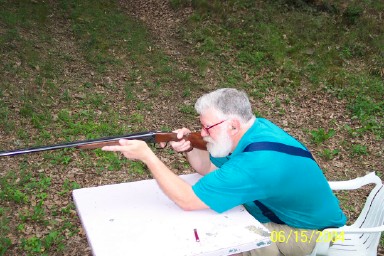
M.W. ---- Photo by Brendon Bergman
|

